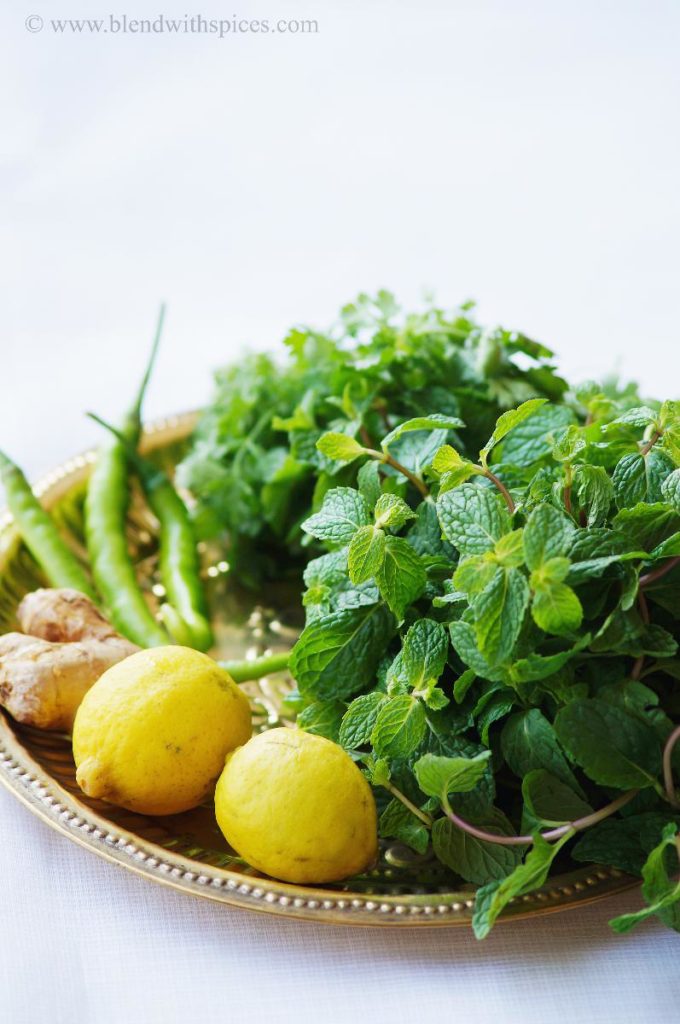
Also, you absolutely must get rid of the stalks and put the leaves only if you're adding mint. Do remember, however, that mint can turn the chutney considerably darker.

In fact, mint coriander chutney is an entity in its own right and I sometimes make it instead of a straight coriander chutney.
Mint leaves are another lovely addition to the chutney. If you're adding yogurt, do away with the lemon juice. Besides, it gives the chutney an added body and tartness. Of course, yogurt will change the colour but it still looks pleasing. A spoonful or two of yogurt is one of them. Having said the above, there are some things you could add. If you throw in things like ground cumin or black salt (amchur), it robs the chutney of its vibrant green hue. After years of making this chutney, I have noticed that less is more and the best taste and color comes with just a dash of salt and pepper. If you want to preserve the bright green color of the chutney, use the freshest coriander you can find on the supermarket shelf and don't add any spices to the ingredients while making it. Strictly speaking, the best chutney is made with just the leaves, but who has the time to separate every leaf from its stalk? This makes for a smoother chutney and unless you have a Vitamix type blender, pureeing it becomes easier sans stalks. Do chop off the thick cilantro stems if you have a moment extra. Or you can use a milder variety of green chilli, Thai chillies being quite hot as you might know. If you like, you can add or subtract the chillies depending on how much heat you can take. I usually put three Thai green chillies in two bunches of cilantro and this makes the chutney moderately hot. Adjust the number of green chillies according to your taste. Becomes difficult to scoop up with a piece of samosa or roll. Don't add too much water while blending the chutney or it might turn runny. (Or make it as hot as you like, and keep a stash of creamy yogurt on hand-a dollop or two will be just enough of a fire extinguisher for any guests who can't take the heat. You can lower the spiciness further by stripping away the seeds and the rib at the center. Use a serrano or a Thai chile when you want a good dose of heat in the chutney a jalapeño will work to give you a milder burn. You make the chutney and reserve half as your dipping sauce, while the other half gets folded into creamy, tangy yogurt to make a flavorful marinade for the chicken. Roast chicken, whole or separated into pieces, benefits brilliantly from chutney-based marinades. I like to stray even further away from its typical applications and use it to marinate chicken. It is bursting with flavor and can take on many roles: toss roasted vegetables in it, or fold it into a bowl of chilled yogurt to make an herby raita. Some versions might contain coconut, while others star herbs like mint or employ unique combinations of spices to add flavor.Those samosa sidekicks aside, green chutney can be much more than a condiment on the edge of a plate. It strips away the nuance and richness from this alluring condiment, which can be made in a thousand different ways. Green chutney is called that for a reason-it's vividly, almost alarmingly verdant in color-but frankly, I think the name does the chutney a disservice. It's much like a chimichurri, but with a more powerful punch. The construction of this alarmingly vivid chutney is quite simple: Fresh herbs, fresh chiles, and a few spices are ground together with a bit of lime juice and water. 
Step into any Indian restaurant and ask for a plate of samosas, and you'll often find them served with a small bowl of bright green chutney that leaves a fiery tingle on the tip of your tongue.






 0 kommentar(er)
0 kommentar(er)
